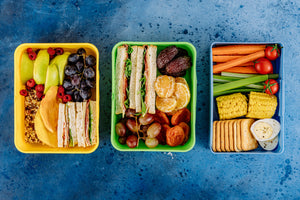Watch These Nutrients in Your Child’s Diet
The transition from infancy to toddlerhood marks a critically important developmental period. Your child’s brain is bursting with more than 100 trillion synapses, enabling him to perform increasingly complex tasks—from walking, then running, jumping, and climbing, to listening and eventually speaking. But he needs a full range of nutrients to support this rapid progress.
Now that he’s no longer solely reliant on breast milk or formula (which won’t meet all of his nutritional needs at this stage), he’s also starting to take a more active role at mealtime. He’s becoming increasingly adept at feeding himself—and increasingly willful when it comes to asserting his taste preferences. With that in mind, perhaps it’s not surprising that this is often a time when nutrient imbalances begin to show up.
According to researchers, there are a number of nutrients that parents should be paying close attention to, as they’re the most likely to be consumed in the wrong amounts—either too little or too much. Here’s a look at a few of the nutrients researchers have identified as problematic.
Fiber
Who’s at risk? Dietary fiber was low in the vast majority of toddler and preschooler participants in a large study—likely because they weren’t getting the recommended amounts of fruits and vegetables, which are natural sources of fiber. Almost one in three ate no vegetables in a given day, and one in four ate no fruit. (Among preschoolers in the study, French fries were the vegetable most often eaten!)
Why is it important? Fiber aids digestion and helps promote satiety, reducing the likelihood of overeating. However, it can also interfere with the absorption of dietary fat, so it shouldn’t be introduced into an infant’s diet until after 6 months old.
What can you do?  Make fruits and vegetables part of every meal and snack—especially after your child grows out of the strained food stage and begins eating finger foods. Offer whole grain cereals and breads, as well, which are good sources of fiber.
Make fruits and vegetables part of every meal and snack—especially after your child grows out of the strained food stage and begins eating finger foods. Offer whole grain cereals and breads, as well, which are good sources of fiber.
Iron
Who’s at risk? Twelve percent of 6- to 11-month-olds don’t receive adequate iron. By about 4 to 6 months old, your baby has diminished the supply of the iron stores accumulated in the womb, and breast milk doesn’t provide enough to replenish them. That’s why, despite the fact that the iron in breast milk is more easily absorbed than that in iron-fortified formula, deficiencies begin to show up in breast-fed babies at around 6 months. Children under 5 who drink more than 32 ounces of cow, goat, or soy milk a day also have an elevated risk of iron deficiency, as the excess milk may decrease their appetite for iron-rich foods.
Why is it important? Babies and toddlers need a great deal of iron to fuel their rapid growth. It’s essential for healthy cell function and carrying oxygen from the lungs to the brain and throughout the body. Numerous studies have found a direct link between lack of iron and deficits in mental and motor development. But excess iron can be harmful, as well, so be sure to consult your pediatrician before starting your baby on a supplement.
What can you do? Iron-fortified formula can help provide the adequate amount of iron. For children eating solid foods, vitamin C helps the body absorb iron. So in addition to iron-rich meat, iron-fortified cereals, and dark green vegetables, serve vitamin C–rich foods, such as melon, berries, tomatoes, and oranges. Those last two may cause a localized skin rash when first offered due to their acidity; just serve them along with other foods to minimize the chance of reaction.
Potassium
Who’s at risk? Early in life, babies absorb potassium from breast milk and formula, but by the 1-year mark they often aren’t getting enough, because their diets don’t include sufficient healthy plant sources.
Why is it important? This essential mineral allows for proper cell functioning throughout the body. It plays a role in neural messaging, muscular function (particularly in the heart), and maintenance of healthy blood vessels.
What can you do?  Serve more fruits and vegetables, including leafy greens, vine fruits (like melons, tomatoes, cucumbers, and pumpkins), and root vegetables. It may require creativity to incorporate potassium in dishes; try adding zucchini to muffin batter or bake chips from roasted, sliced beets or kale.
Serve more fruits and vegetables, including leafy greens, vine fruits (like melons, tomatoes, cucumbers, and pumpkins), and root vegetables. It may require creativity to incorporate potassium in dishes; try adding zucchini to muffin batter or bake chips from roasted, sliced beets or kale.
Saturated Fat
Who’s at risk? For most children, fat doesn’t need to be restricted during the first two years of life, but after age 2, your toddler should get no more than 30 percent of his calories from fat (averaged over several days). Three-fourths of preschoolers in a large study consumed too much saturated fat, however, with half of it coming from whole or 2 percent milk.
Why is it important? Babies and toddlers need healthy fats to support brain development, bolster the immune system, and process fat-soluble vitamins. But saturated fat contains higher amounts of unhealthy cholesterol and increases the risk of heart disease, obesity, and other health problems.
What can you do? Switch to lower fat milk (1 percent or nonfat), reduced-fat cheese, and other low fat or nonfat dairy products as soon as your child’s doctor says it’s OK. Healthy fat choices also include avocado, fish, and foods made with olive, safflower, or canola oils.
Sodium
Who’s at risk? Researchers found that 45 percent of 12- to 23-month-olds and 78 percent of 2- to 4-year-olds exceeded the recommended sodium intake in their diets.
Why is it important? Sodium is essential for maintaining the water balance in the body, regulating blood volume, and ensuring proper cell and tissue function. But consumed in excess, it can lead to high blood pressure and elevate the risk for heart disease and stroke.
What can you do? Check food labels for sodium content. In 2013, Centers for Disease Control researchers evaluated more than 1,000 food products for babies and toddlers, including cereal bars and crackers, and they found that more than 75 percent contained too much sodium. (Baby foods, which contain fewer ingredients overall, tended to have less sodium.) Serve fewer processed foods, which are high in sodium. Avoid bacon, hot dogs, and sausage—all high-sodium meats that your toddler doesn’t need—as well as store-bought cookies, chips, and candy.
References:
“Nutrition and the developing brain: Nutrient priorities and measurement” by MK Georgieff, Am J Clin Nutr (2007).
Zero to Three. Available at: http://www.zerotothree.org/child-development/braindevelopment/faqs-on-the-brain.html
Infant Nutrition and Feeding: USDA. Available at: http://www.nal.usda.gov/wicworks/Topics/FG/CompleteIFG.pdf
“What's Going on in There? How the Brain and Mind Develop in the First Five Years of Life?” by Lise Elliot.
Dietary Reference Intakes: The Essential Guide to Nutrient Requirements. Available at: http://www.nap.edu/catalog/11537.html
“Food consumption patterns of young preschoolers: Are they starting off on the right path?” by Fox MK, J Am Diet Assoc (2010).
“Food consumption patterns of infants and toddlers: Where are we now?” by Siega-Riz AM et al., J Am Diet Assoc (2010).
“Primary Prevention of Allergic Disease Through Nutritional Interventions” by David M. Fleischer et al., J Allergy Clin Immunol (2013).
“Nutrient Intakes of US Infants, Toddlers, and Preschoolers Meet or Exceed Dietary Reference Intakes” by Nancy F. Butte et al., Journal of the American Dietetic Association (2010).
American Heart Association: Reducing Sodium in the Diets of American Children. Available at: https://www.heart.org/idc/groups/heart-public/@wcm/@adv/documents/downloadable/ucm_433027.pdf
American Heart Association: Know your fats. Available at: http://www.heart.org/HEARTORG/Conditions/Cholesterol/PreventionTreatmentofHighCholesterol/Know-Your-Fats_UCM_305628_Article.jsp






